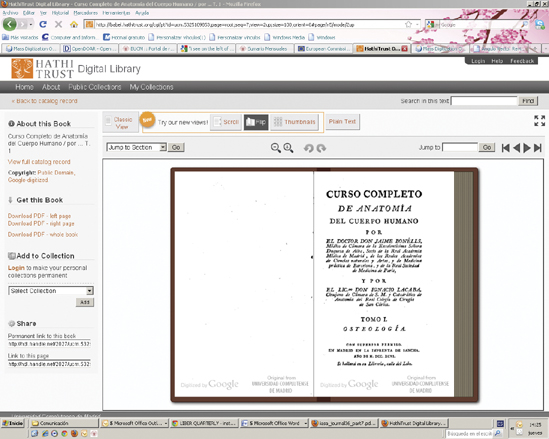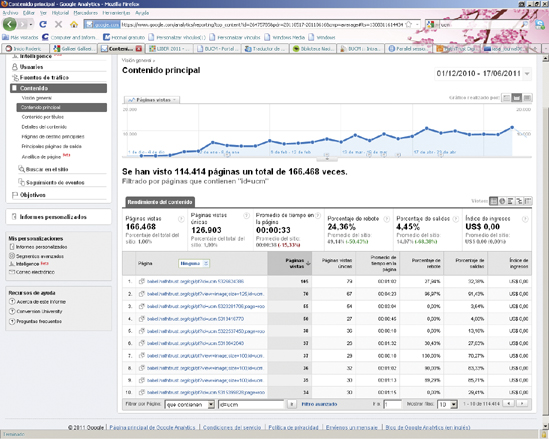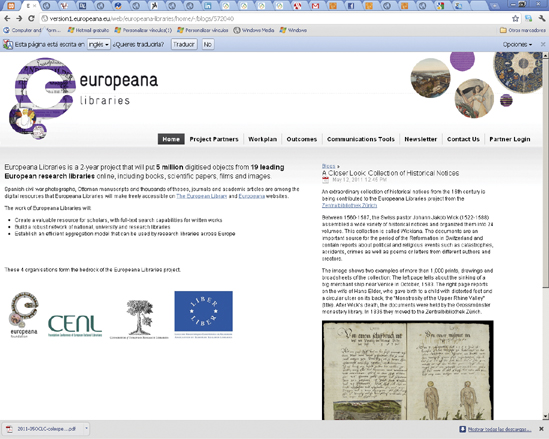Access to and Preservation of its Cultural Heritage
In the mid-1990s, the Library of the Complutense of Madrid (UCM) applied the growing body of new technologies to a pioneering project: the digitization of a valuable collection of biomedical books. The result of the project was the Dioscorides Digital Library. Up to 2006, however, the pace of digitization was very slow, resulting in only 3,000 books and 50,000 digitized engravings.
In September 2006, the Complutense University and Google signed a partnership agreement for the purpose of carrying out large-scale digitization of our public domain collections. The Complutense University Library is participating in this mass-digitization project with the following goals:
-
To improve the discovery of the cultural heritage of Complutense and increase the number of potential readers;
-
To fulfil its public service mission;
-
To preserve and protect the original books;
-
To enhance students’ and faculty research.
By early 2011, the Complutense Library had digitized roughly 120,000 out-of- copyright books from the 16th to the 19th centuries. All these materials are easily accessible via the Complutense Library Catalogue, Google Books and HathiTrust Digital Library. The Complutense University of Madrid joined the HathiTrust Digital Library in November 2010, which allowed books digitized by Google to be stored on HathiTrust servers. The HathiTrust Digital Library is both a digital preservation repository and a platform for access. It provides long-term preservation and access services for public domain and in-copyright content from a variety of sources, including Google, the Internet Archive, Microsoft, and in-house partner institution initiatives. In early 2011, the number of HathiTrust public domain volumes reached the two million mark and the collection exceeded eight million volumes.
In addition, and complementing the above, the digital content of the Complutense University Library will be aggregated to Europeana during 2011 and 2012.
For more than two decades, academic and research libraries have been undergoing continuous transformation as a reaction to major changes inside and outside their environment. Our strategic lines of action are determined by three ideas:
-
The life of libraries can no longer be conceived in pre-digital terms. We are experiencing the final transition from the analogue to the digital era (we only have to think of e-journals, e-books, repositories, etc.).
-
There is a relationship between the digital content and the digital tools used in the creation and management of the former since both share the same characteristics.
-
Increasing accessibility and use of information are the result of bringing both the content and the tools in line with each other in order to break down barriers to information flows related to learning, teaching and research activities. Any remaining barriers are essentially economic or political rather than technical.
In this globalized world universal access to culture and science is now considered a right. Libraries, as conspicuous custodians of cultural heritage, should be fully involved in the systems that are available for improving the dissemination of knowledge.
Therefore, like other libraries, the Library of the Complutense University of Madrid (henceforth referred to as UCM) has had to redefine its strategy for disseminating knowledge and research. Firstly, in order to serve the UCM academic community, the Library has made it easier to access the most recent outcomes from international R&D activities; secondly, to serve the global academic community and the general public, it has promoted the dissemination of historically accumulated research conducted by UCM scholars, the ultimate goal being that the cultural and scientific resources of UCM should be universally accessible and properly preserved.
In order to carry out this strategy, we have developed three lines of action within a framework that emphasizes international cooperation as the best way to ensure the survival of academic and research libraries in the future. The first line of action, which is the specific subject matter of this paper, is building collections through digitization and reformulation of the preservation policy of digital and printed documents. As Conway notes, it is necessary to distinguish between digitization for preservation (creating new digital products from physical artifacts) and digital preservation (protecting the value of the products created, irrespective of whether the original sources are tangible artifacts or born-digital data) (Conway, 2010). Each of these tasks has different standards, processes, technologies, costs and organizational challenges. The second line is related to the organization of knowledge and is aimed at enhancing access, while the third line furthers the development of mechanisms that enable the delivery and use of such knowledge.
In order to create new digital collections that can spread the Spanish cultural and scientific heritage hosted in the UCM Library, a partnership agreement was signed with Google in 2006 for digitizing our public domain collections. The amount of human and economic resources required for preserving a digital copy of more than 120,000 UCM books digitized by Google was so large that the viability of the Library was jeopardized. In our view, only international cooperation can enable academic and research libraries to meet such a challenge. Therefore, UCM decided to join the HathiTrust Digital Library in November 2010.
In addition, and reinforcing this strategy, UCM joined the new ‘Europeana Libraries’[1] project, funded by the European Commission, in January of 2011. This project complies with the provisions laid down by the European Union in its European Digital Agenda (European Commission, 2010) and with recommendations by the Comité des Sages on the Digitization of European Cultural Heritage (European Commission, Comité des Sages, 2011), which both draw attention to the urgent need for all materials digitized with public funding to be aggregated to Europeana by 2016.
In a move to improve the organization of, access to and use of our digitized collections by the UCM community, two Complutense research teams have combined their efforts to work on a method that will allow collaborative annotations of literary texts and the collaborative creation of annotation schemas. This project, entitled ‘Collaborative Annotation of Digitalized Literary Texts’, is funded with one of the 12 grants awarded by Google in its 2010 Digital Humanities Research Awards Program.[2]
These innovative projects have been actively supported by our academic authorities (President, Vice-Presidents, Deans, etc.) and have been welcomed by the UCM community.
In the mid-1990s, the UCM Library created the Dioscorides Digital Library with the aim of digitizing and providing access to a selection of works from its historical collection of biomedical books. By 2006, approximately 3,000 books and 50,000 engravings from the fifteenth to the nineteenth centuries, including manuscripts and printed books, had been digitized.
After the results of this project had been assessed, three conclusions were drawn: a) the pace of digitization had been slow, which made it very difficult to extend the project to include all of UCM’s cultural heritage within a reasonable period of time, b) budgetary constraints limited any expansion of the project, and c) dissemination on the Internet was poor, owing to the local nature of the project. It was therefore necessary to find an alternative digitization model and migrate from the ‘boutique model’ to the large-scale model that by then was already being implemented by Google through the Book Search project.
In September 2006, UCM and Google signed a cooperation agreement with the aim of digitizing public domain collections in its Library and offering free online access. The University contributed its holdings and the staff needed to select and handle the documents to be digitized, while Google took care of the costs of digitization. Two copies of the digitized material were produced, one for UCM and the other for Google. The specific goals of the UCM Library were:
-
To promote access to and dissemination and preservation of the cultural heritage of UCM in the public domain.
-
To add the UCM holdings to those of major libraries already participating in the Google project (Michigan University, Stanford University, Harvard University, Oxford University and New York Public Library) in order to facilitate access to scholarly knowledge by the global academic community and the general public.
-
To provide a cutting-edge information system for accessing the cultural heritage of the Library.
-
To design a plan for the conservation and restoration of damaged books.
-
To provide UCM scholars, especially those ones working in the fields of social sciences and humanities, with a corpus of digital materials that enable digital projects to be developed.
In accordance with the agreement with Google, the UCM library established a working group to draw up the digitization plan, monitor its progress and prepare reports on its development. The group undertook the following activities:
-
Analysis of the collections and storage spaces. Firstly, the collections and the spaces where they were stored were examined, with the following objectives:
-
To ascertain the number of public domain volumes to be digitized and their distribution over the 32 locations of the UCM Library.
-
To obtain information on the facilities and accessibility in the above-mentioned locations and any potential difficulties that may arise.
-
To carry out a survey of the collections, including the organization system, conservation conditions and number of non-catalogued books.
-
To specify, before and after selecting the material, the tasks required for completion of the project, as well as the staff needed for this purpose.
-
-
Cataloguing Plan. In December 2006, a cataloguing plan was drawn up for non-catalogued materials dating from the 16th to the 19th centuries. In total, approximately 220,000 volumes were catalogued.
-
Selection Guidelines. The selection of volumes was based on three main variables: date of publication (from the 16th century to 1870), physical condition of the item (dimensions, text block and binding conditions) and fitness for scanning.
-
Binding of 19th-century books. A sample of data revealed that binding issues could be a serious obstacle to digitization. To overcome this, the restoration department of the UCM Library drew up a list of technical recommendations for the proper binding of 19th century books. As a result, it was possible to digitize many previously discarded volumes and improve their conservation.
In mid-2007 the workflows and logistic operations required for the digitization process were established for all UCM Library locations. In order to control the project workflows, the Library developed several applications for logistics management in cooperation with the university’s IT services.
A web application providing real-time information on all the processes involved in scanning, with concrete data and statistics. This application stores book metadata in the catalogue included in the digitization programme and also offers a complete overview of the daily movements of books in each location and books selected to be sent to Google. At the same time, it shows automatically updated information on the availability or status of the item in the UCM Cisne catalogue.
An application used directly through a PDA by selection teams in the stacks. When the application reads the book’s barcode, a form is displayed on the touch screen for the librarian to evaluate features relating to the physical conditions of the book. This information is then dispatched to the item record in the web application, where the dimensions of the books are registered, together with aspects of their state of conservation (presence of fungi, degree of physical deterioration, loose or brittle pages, whether the binding is valuable, weak or absent, etc.). A summary of this information is automatically forwarded to the Cisne catalogue records in a note field (Figure 1).
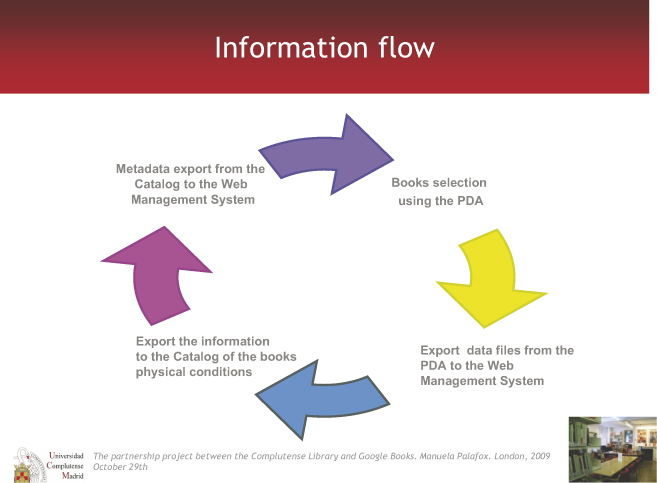
Figure 1: Information flow.
This process has provided the Library with very comprehensive information on the conservation of its historic collection: some 13% of the pre-1871 volumes (about 19,000 out of 140,000) have issues that exclude them from the digitization project. The main issues are related to text block (2% brittle pages, 10% fungi, 20% loose pages, 21% uncut pages and the remaining 47% other physical damages) (Figure 2) and binding (5% non-open, 10% lost, 25% weak, 30% requiring rebinding, and 30% very much damaged) (Figure 3). Knowing these figures and being able to identify each item with conservation issues allows us to devise a restoration plan including the economic cost. However, budgetary constraints have made it impossible to implement such a plan at the present time.
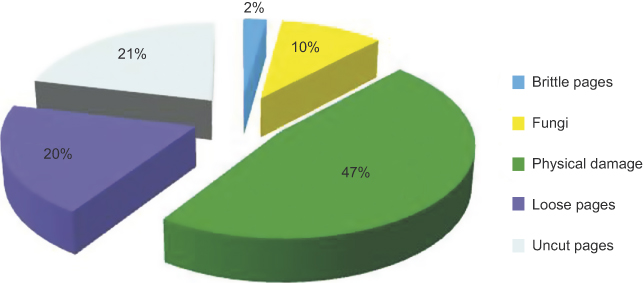
Figure 2: Text block problems.
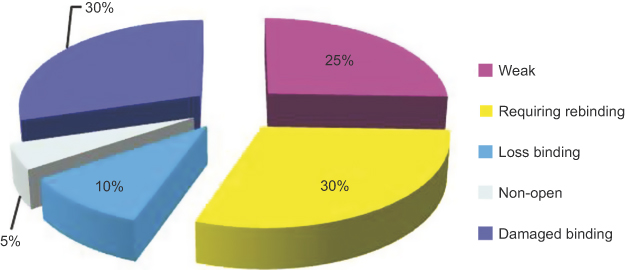
Figure 3: Binding problems.
Digitized books are available through three websites: the Cisne catalogue of the UCM Library, Google Books and HathiTrust. The Cisne catalogue has links to the digital volume and also a box for full-text searching. The web application for logistical management produces a daily script for accessing GRIN, the Google partners management interface, obtains the item identifiers (barcodes) with the full text from Google Books and adds an 856 MARC label to the Cisne record, thus providing a link to the digital copy in Google Books. Cisne also runs another script that uses a Google API[3] to check whether there is a digital copy of a book in Google Books; if this is the case, the Cisne catalogue will show a search box. Another link will shortly be added to the UCM digital copy stored in HathiTrust, as shown in Figure 4.
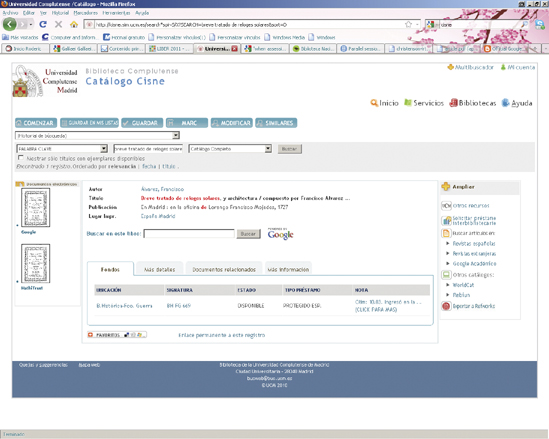
Figure 4: Cisne Catalogue, access to full text books (Google and HathiTrust).
One of the main motivations behind the UCM agreement with Google was to ensure that our public domain collections would remain accessible to future generations. If users access digital copies instead of the original materials, then the handling of original books is kept to a minimum and the preservation function comes into play.
According to the UCM Management Collections Policy,[4] ‘the UCM Library policy of preservation of digital resources is based on activities and interventions required to ensure long-term accessibility and legibility of reliable digital objects required by the University for the purposes of learning, teaching, researching and other activities related to institutional objectives.’
With respect to digitization specifications, the preservation formats for images from in-house digitization projects in the UCM Library are TIFF and JPEG. The Library uses PREMIS[5] structured according to the METS[6] (Metadata Encoding & Transmission) scheme, in accordance with recommendations from the Spanish Department of Culture.[7]
Throughout the year 2010, our IT services and Library staff were engaged in the joint exploration of a common infrastructure strategy, aimed at significantly enhancing our capability for preserving and accessing the UCM cultural heritage digitized by Google. Two needs were identified for implementing a digital preservation programme: 1) a large-scale digital content repository, and 2) a scaleable technological and organizational potential. We concluded that these requirements were so important that digital preservation could only be achieved through the cooperative involvement of academic institutions following international library community standards. As a result, in November 2010 the UCM joined HathiTrust: ‘Because scholarly needs can often be more readily addressed by organizations and initiatives that are focused on academia, the creation of HathiTrust and its relationship with Google is especially promising. In essence, Hathi will bring an enormous collection of digitized books, including many of those scanned through Google partnerships, under the control of an enterprise principally driven by a scholarly mission. Hathi’s digital preservation mission is vital, and its partnership model allows participating libraries to achieve scale and quality far greater than that which any of them could do on their own’ (Schonfeld, 2010).
The HathiTrust digital repository was launched in 2008 by a partnership of major US research libraries whose aim was to preserve and provide access to digitized books and journals through collaboration. Currently, more than fifty libraries who are partners in HathiTrust have digitized their collections in mass digitization projects, including digitization by Google and Internet Archive, as well as in-house initiatives. ‘These libraries have a common vision to build a new kind of library for the 21st century — a cooperative library founded on principles of commitment, deep resource sharing, and trust, that was so comprehensive in its representation of the published record, so available to users anywhere in the world, and so broad in its impact on the fundamental business of what libraries do, that it could rise to be called a universal library’ (York, 2010).
HathiTrust is committed to bit-level preservation and format migration of materials as technology, standards, and best practices in the digital library community change. HathiTrust strives to ensure that the digital content it preserves is accurate, complete, suitable for long-term preservation, and useful for a variety of access purposes. It does this through consideration of content file formats, preservation and descriptive metadata, validation routines, and attention to quality.[8]
HathiTrust serves a dual role. First, as a trusted repository it guarantees the long-term preservation of the materials it holds, providing the expert curation and consistent access long associated with research libraries. Second, as a service for partners and a public good, HathiTrust offers persistent access to the digital collections. This includes viewing, downloading, and searching access to public domain volumes, and searching to in-copyright volumes. Specialized features are also available which facilitate access by persons with print disabilities, and allow users to gather subsets of the digital library into ‘collections’ that can be searched and browsed.[9]
As of June 8, 2011 HathiTrust partners had contributed 8,800,666 volumes, of which 4,800,890 were book titles and 213,244 serial titles. The number of volumes in the public domain was 2,400,247 (˜27% of the total).[10] HathiTrust is investigating issues relating to the storage and delivery of electronic publications (in the ePub format in particular) and digital audio and image files (Beers et al., 2010).
As shown in Figure 5 (York, 2011), over 75% of the content is contributed by the collections of Michigan and California Universities, which have digitized both out-of and in-copyright collections. The Complutense University of Madrid owns 1% of the total content.
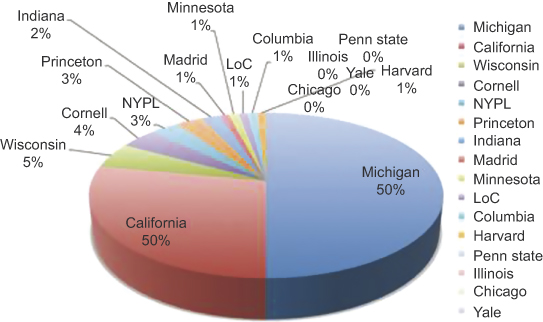
Figure 5: HathiTrust content (data as of May 1, 2011).
The repository was designed in accordance with the Open Archival Information Systems (OAIS) reference model.[11] Preservation information is recorded using PREMIS, and is compliant within the context of community-wide standards and criteria for Trustworthy Digital Repositories Audit & Certification (TRAC).[12] The repository utilizes a robust technology and has the geographic redundancy of two mirror sites at the University of Michigan and Indiana University.
Two components are required for ingest in HathiTrust: bibliographic metadata and content. Accurate bibliographic records for submitted content are provided by the institutions before content ingestion. The records act as a manifest of the digital content and are used as part of HathiTrust’s digital object management strategy. The UCM Library delivers the bibliographic metadata via download from a source. Specifications for bibliographic metadata are:
-
Data in MARCXML format in utf-8 encoding
-
One bibliographic record per item (multi-volume works should have the same record repeated for each item)
-
Complutense system number in 001 field
-
Barcode in 955|b
-
Item description (enumeration/chronology) in 955|v.
The namespace identifier is determined by the institution. HathiTrust distinguishes content in the storage system by creating a new namespace for each institution, and each body of content within an institution has a unique identifier scheme. The namespace is four characters long at most and is followed by a unique (in that namespace) identifier. This is often, but not always, the physical item barcode. The two together (namespace plus identifier) comprise an object’s repository identifier. For example: ucm.5325109853.
HathiTrust uses the Handle system () to assign permanent URL’s to repository objects. For example:  http://hdl.handle.net/2027/ucm.5325109853
http://hdl.handle.net/2027/ucm.5325109853
The UCM Library uses a hybrid format for scanned volumes containing bitonal TIFF files for all-text pages and JPEG2000 files for images. UCM ingests the digital content digitized by Google and other materials digitized in-house, such as incunabula and manuscript collections. Ingest started in December, 2010 (Table 1).
Table 1: UCM Ingest into HathiTrust.
| Date | Volumes | Total |
| December 2010 | 78,256 | 78,256 |
| January 2011 | 1,156 | 79,412 |
| February 2011 | 6,125 | 85,537 |
| March 2011 | 2,774 | 88,311 |
| April 2011 | 15,486 | 103,797 |
| May 2011 | 2,947 | 106,744 |
